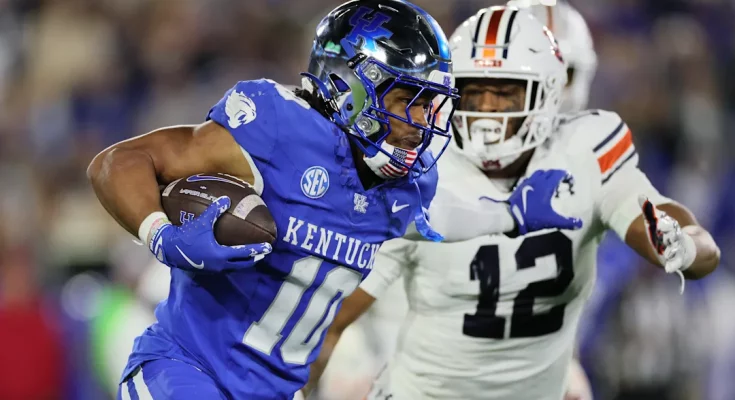Kentucky football has always occupied a unique place in the college football landscape. Often overshadowed by perennial powerhouses in the Southeastern Conference, the Wildcats have nonetheless built a program with a steady mix of competitiveness, grit, and flashes of brilliance that can catch even seasoned analysts off guard. In recent weeks, Kentucky football has found itself on a list that few could have predicted, a ranking or recognition that has not only surprised fans but also sparked conversations across the broader college football community. To understand why this recognition is significant, it’s important to look at the trajectory of the program, the changes in coaching and recruitment strategies, and the performances on the field that have contributed to this unexpected acknowledgment.
Under the leadership of Mark Stoops, the Wildcats have steadily improved their standing in the SEC, a conference known for producing national champions and Heisman contenders. Stoops, who has been at the helm since 2013, has consistently focused on building a program that emphasizes strong defensive play, disciplined offensive schemes, and the development of players both on and off the field. Over the past decade, Kentucky has made incremental progress, from struggling seasons to competing for bowl eligibility and occasionally challenging the top teams in the SEC. This long-term vision and patient approach have laid the groundwork for the recognition Kentucky is now receiving.
Recruiting has been a cornerstone of Kentucky’s rise in recent years. Traditionally, the Wildcats have had to compete with elite programs in neighboring states, such as Alabama, Georgia, and Florida, for top-tier talent. Despite these challenges, Kentucky has managed to land impactful players, often targeting under-the-radar prospects who develop into key contributors. This recruitment strategy has helped the Wildcats not only build depth across the roster but also cultivate a culture of growth and resilience. Many of the players who have emerged under Stoops’ guidance were not necessarily the most highly touted coming out of high school but have blossomed into standout athletes due to the program’s commitment to player development.
The coaching staff, beyond Stoops himself, has played a pivotal role in elevating Kentucky football to this newfound recognition. Coordinators and position coaches have brought fresh ideas and a willingness to adapt schemes to fit the strengths of their personnel. The offensive and defensive units have shown an increasing level of sophistication, with offensive coordinators finding ways to maximize the talents of skill players, while defensive coordinators have constructed schemes that can disrupt some of the most potent offenses in the country. This level of coaching acumen, combined with a strong recruiting pipeline, has allowed Kentucky to perform at a level that has begun to demand national attention.
On the field, the Wildcats have demonstrated resilience and the ability to compete against formidable opponents. In recent seasons, Kentucky has recorded victories that have startled even seasoned college football analysts, including wins over traditional SEC powers. These signature wins are often what elevate a program’s profile, signaling that the team is capable of more than expected. Beyond individual victories, consistent competitiveness in each game has shown that the Wildcats are no longer merely participants in the SEC landscape but legitimate contenders who can challenge higher-ranked teams and influence conference standings.
One of the key factors behind Kentucky’s placement on this surprising list is the program’s ability to blend experience with emerging talent. Seasoned upperclassmen provide leadership and stability, while incoming freshmen and transfers bring fresh energy and new dynamics to the roster. This balance allows the team to maintain competitiveness week in and week out while continuing to build for future success. The Wildcats’ depth has been particularly noteworthy, as injuries and unforeseen challenges are inevitable over the course of a demanding season. Kentucky’s ability to adapt and perform even when facing adversity speaks volumes about the culture cultivated within the program.
The program’s commitment to player development extends beyond athletic performance. Academic support, leadership training, and community involvement are all emphasized, creating well-rounded student-athletes who represent the university positively on and off the field. This holistic approach has likely contributed to the broader recognition of the Wildcats, as programs that produce successful and responsible athletes are often celebrated not only for wins but also for the overall quality of their operations.
In addition to on-field success and player development, Kentucky football has leveraged media coverage and strategic messaging to enhance its profile. Social media, broadcast appearances, and engagement with national outlets have allowed the Wildcats to highlight their achievements and unique stories, capturing the attention of a wider audience. The program’s visibility has increased, making it easier for analysts, fans, and recruiters to appreciate the strides Kentucky has made in recent years. This enhanced profile likely contributed to the Wildcats appearing on the list, as recognition often follows both performance and visibility in today’s media-driven sports landscape.
The list itself is notable because it reflects an aspect of college football that is often overlooked: programs that show consistent improvement, innovation, and resilience, even if they are not traditional powerhouses. Kentucky’s inclusion underscores that the landscape of college football is not static, and programs that are well-managed and strategically positioned can achieve recognition alongside more historically dominant schools. This acknowledgment can have ripple effects, from boosting recruiting efforts to energizing the fan base, and even impacting scheduling and media opportunities in future seasons.
Fan engagement has also been a crucial element of Kentucky’s rise. The support from the Wildcats’ faithful has grown alongside the team’s competitiveness, creating a dynamic and energized atmosphere at home games. Kroger Field has become a place where opponents face not only a talented team but also a passionate crowd that can influence the momentum of a game. This level of fan support is often a key factor in elevating a program’s profile, as it demonstrates community investment and a sustainable foundation for success.
Kentucky’s place on this surprising list is also a testament to the program’s long-term vision. Many college football programs focus on short-term success, aiming for quick wins at the expense of sustainable growth. Kentucky, under Stoops and his staff, has charted a different course, emphasizing consistent improvement, player development, and a competitive culture that can endure beyond individual seasons. The recognition the program has received is, in many ways, a validation of this patient and methodical approach, showing that thoughtful program-building can yield attention and respect from the broader college football community.
Looking ahead, this recognition may serve as a catalyst for further success. Being on a national list, particularly one that highlights programs making strides or exceeding expectations, can attract new recruits who want to be part of a rising program. It can also draw increased media attention, sponsorship opportunities, and institutional support, all of which can reinforce the program’s upward trajectory. For the coaching staff and players, this acknowledgment is likely a motivating factor, reinforcing that their hard work is being noticed and valued on a larger stage.
Moreover, Kentucky’s recognition challenges preconceived notions about the hierarchy of college football. Programs that were once seen primarily as underdogs are increasingly capable of making their mark, demonstrating that strategic vision, strong leadership, and a commitment to development can disrupt traditional power dynamics. Kentucky’s inclusion on this list is symbolic of a broader shift in the sport, where excellence is recognized in more nuanced ways than merely counting conference titles or national championships.
In conclusion, Kentucky football’s unexpected appearance on this national list is a reflection of a program that has steadily built itself into a respected competitor through strategic planning, strong coaching, effective recruiting, and a commitment to player development. The Wildcats have demonstrated the ability to compete against elite competition, develop under-the-radar talent into standout performers, and maintain resilience in the face of adversity. Their recognition on this list is not just a momentary accolade but a signal that Kentucky football is being taken seriously on a national stage. As the program continues to grow and evolve, this acknowledgment may serve as both a reward for past efforts and a stepping stone toward even greater achievements in the future. The Wildcats have shown that with vision, patience, and determination, programs can surpass expectations and earn respect in ways that might once have seemed unlikely, proving that Kentucky football is a force to be reckoned with in college football’s competitive landscape.
This milestone is not merely a surprise; it is an affirmation of what Kentucky football has been building for years—a program defined by perseverance, strategic growth, and an unwavering commitment to excellence. It highlights the tangible results of a methodical approach and sets the stage for continued success, inspiring players, coaches, and fans alike to believe in the potential of what the Wildcats can achieve in the seasons to come. Kentucky football’s journey is a reminder that in college athletics, progress is often the most compelling story, and the Wildcats are now firmly a part of that narrative.



